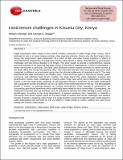| dc.contributor.author | Nelson Obange, George G Wagah | |
| dc.date.accessioned | 2020-08-25T12:35:08Z | |
| dc.date.available | 2020-08-25T12:35:08Z | |
| dc.date.issued | 2019 | |
| dc.identifier.uri | https://repository.maseno.ac.ke/handle/123456789/2386 | |
| dc.description.abstract | Rapid urbanization often results in land tenure conflicts commonly in urban fringe areas. Overly, this is
attributed to lack or in some instance unclear urban planning schemes. Kisumu city, the third largest city in
Kenya has experienced rapid urbanization as a result of high rural-urban human migration in search of
informal/informal employment. Consequently Kisumu urban sprawl is highly characterized by gentrification
challenges and land tenure disputes in its fringes. The study sought to provide a comprehensive national
and local overview of the historical and legal context of land tenure challenges as a result of urbanization in
Kenya and Kisumu in particular. The study used document content analysis technique to review records at
the lands office and county city planning office. Key informant interview and focus group discussion were
conducted on different socio-economic group from the informal settlements of Nyalenda A and B. The study
established that land ownership is an emotive issue. There are three types of land tenure namely; public,
communal and individual land tenure. Further, the study found that urban population pressure and
gentrification remain major challenges in Kisumu urban fringe land which were traditionally communally
owned. In the two study areas: Nyalenda ‘A’ the population density is 8,953 per sq. km while Nyalenda B
has a population density of 6,886 per sq. km, far above most residential areas of the city. The demographic
growth in Kisumu is exerting pressure on housing development which typically is extending to the
surrounding agricultural hinterlands which traditionally were owned by local communities. Consequently, the
traditional communal land use practices such as subsistence farming and cattle herding is under threat of
gentrification. According to the study respondents, a stylized continuum from: leaseholds to freehold to
community land tenure system would be the best model to resolve land tenure challenges and enhance
security of tenure in Nyalenda urban fringe. The study therefore recommend stylized model (model based on
public participation) but anchored on the UN-HABITAT model (2008) to resolve conflicts over land tenure
arising from Kisumu urban sprawl. | en_US |
| dc.publisher | Net Journal of Social Sciences | en_US |
| dc.subject | Urbanization, urban sprawl, land tenure, urban fringes, Kisumu, Kenya | en_US |
| dc.title | Land tenure challenges in Kisumu City, Kenya | en_US |
| dc.type | Article | en_US |

